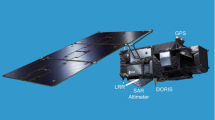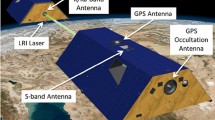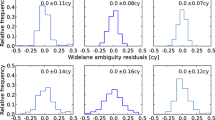Abstract
Recent studies have demonstrated the usefulness of global positioning system (GPS) receivers for relative positioning of formation-flying satellites using dual-frequency carrier-phase observations. The accurate determination of distances or baselines between satellites flying in formation can provide significant benefits to a wide area of geodetic studies. For spaceborne radar interferometry in particular, such measurements will improve the accuracy of interferometric products such as digital elevation models (DEM) or surface deformation maps. The aim of this study is to analyze the impact of relative position errors on the interferometric baseline performance of multistatic synthetic aperture radar (SAR) satellites flying in such a formation. Based on accuracy results obtained from differential GPS (DGPS) observations between the twin gravity recovery and climate experiment (GRACE) satellites, baseline uncertainties are derived for three interferometric scenarios of a dedicated SAR mission. For cross-track interferometry in a bistatic operational mode, a mean 2D baseline error (1σ) of 1.4 mm is derived, whereas baseline estimates necessary for a monostatic acquisition mode with a 50 km along-track separation reveal a 2D uncertainty of approximately 1.7 mm. Absolute orbit solutions based on reduced dynamic orbit determination techniques using GRACE GPS code and carrier-phase data allows a repeat-pass baseline estimation with an accuracy down to 4 cm (2D 1σ). To assess the accuracy with respect to quality requirements of high-resolution DEMs, topographic height errors are derived from the estimated baseline uncertainties. Taking the monostatic pursuit flight configuration as the worst case for baseline performance, the analysis reveals that the induced low-frequency modulation (height bias) fulfills the relative vertical accuracy requirement (σ<1 m linear point-to-point error) according to the digital terrain elevation data level 3 (DTED-3) specifications for most of the baseline constellations. The use of a GPS-based reduced dynamic orbit determination technique improves the baseline performance for repeat-pass interferometry. The problem of fulfilling the DTED-3 horizontal accuracy requirements is still an issue to be investigated. DGPS can be used as an operational navigation tool for high-precision baseline estimation if a geodetic-grade dual-frequency spaceborne GPS receiver is assumed to be the primary instrument onboard the SAR satellites. The possibility of using only single-frequency receivers, however, requires further research effort.
Similar content being viewed by others
References
Bamler R, Hartl P (1998) Synthetic aperture radar interferometry. Inverse Problems 14:R1–R54
Busse FD (2003) Precision formation-state estimation in low earth orbit using carrier differential GPS. PhD Dissertation, Dept of Aeronautics and Astronautics, Stanford University, Stanford
Case K, Kruizinga G, Wu S (2002) GRACE level 1B data product user handbook. JPL Publication D-22027, Jet Propulsion Laboratory, Pasadena
D’Amico S, Montenbruck O (2006) Proximity operations of formation flying spacecraft using an eccentricity/inclination vector separation. AIAA J Guidance, Control Dynamics (in press)
Evans NB, Lee P, Girard R (2002) The Radarsat 2&3 topographic mission: an overview. In: Proceedings of the international geoscience and remote sensing symposium (IGARSS), Toronto, June
Ferretti A, Prati C, Rocca F, Monti Guarnieri A (1997) Multibaseline SAR interferometry for automatic DEM reconstruction. In: Proceedings of the 3rd earth remote sensing (ERS) symposium, Florence, March
Fiedler H, Krieger G (2004) Close formation flight of passive receiving micro-satellites. In: Proceedings of the 18th international symposium on space flight dynamics (ISSFD), Munich, October
Gatelli F, Monti Guarnieri A, Parizzi F, Pasquali P, Prati C, Rocca F (1994) The Wavenumber shift in SAR Interferometry. IEEE Trans Geosci Remote Sensing 32(4):855–865
Gill E, Runge H (2004) Tight formation flying for an along-track SAR interferometer. Acta Astronaut 55:473–485
Goldstein RM, Zebker HA and Werner CL (1998) Satellite radar interferometry: Two dimensional phase unwrapping. Radio Sci 23(4):713–720
Haines B, Bertiger W, Desai S, Kuang D (2002) Initial orbit determination results for Jason-1: towards a 1-cm Orbit. Proc ION-GPS02, Portland
Hanssen RF (2001) Radar interferometry: data interpretation and error analysis. Kluwer, Dordrecht
Hoffmann-Wellenhoff B, Lichtenegger H, Collins J (2001) GPS theory and practice, 5th edn. Springer, Wien New York
IJssel J. van den, Visser P (2003) CHAMP Precise orbit determination using GPS data. Adv Space Res 31(8):1889–1895
Kohlhase AO, Feigl KL, Massonnet D (2003) Applying differential InSAR to orbital dynamics: a new approach for estimating ERS trajectories. J Geod 77:493–502 DOI 10.1007/s00190-003-0336-3
Krieger G, Fiedler H, Mittermayer J, Papathanassiou K, Moreira A (2003) Anaylsis of Multistatic Configurations for Spaceborne SAR Interferometry. Proc Radar Sonar Navigat 150(3):87–96
Krieger G, Moreira A, Hajnsek I, Hounam D, Werner M, Riegger S, Settelmeyer E (2004) A Tandem TerraSAR-X Configuration for SAR Interferometry. Proc RADAR04, Toulouse, October
Kroes R, Montenbruck O (2004) Spacecraft formation flying. GPS World 4:37–42
Kroes R, Montenbruck O, Bertiger W, Visser P (2004) Precise GRACE baseline determination using GPS. GPS Solutions 9:21–31 DOI 10.1007/s10291-0123-5
Leung S, Montenbruck O (2005) Real-time navigation of formation-flying spacecraft using global-positioning-system measurements. J Guidance Control Dynamics 28(2):226–235
Martin M, Klupar P, Kilberg S, Winter J (2001) TechSat 21 and revolutionizing space missions using microsatellites. Rep SSC01-1-3 of AIAA
Massonnet D, Feigl KL (1998) Radar interferometry and its applications to changes in the earth’s surface. Rev Geophys 36:441–500
Massonnet D (2001) Capabilities and limitations of the Interferometric Cartwheel. IEEE Trans Geosci Rem Sensing 31(3):455–464
Montenbruck O, Gill E (2000) Satellite orbits: models, methods, and applications. Springer, Berlin Heidelberg New York
Montenbruck O, Kroes R (2003) In-flight performance analysis of the CHAMP BlackJack GPS Receiver. GPS Solutions 7:74–86 DOI 10.1007/s10291-003-0055-5
Montenbruck O, Van Helleputte T, Kroes R, Gill E (2004) Reduced dynamic orbit determination using GPS code and carrier measurements. Aerospace Sci Technol 9(3):261–271
Moreira A, Krieger G, Hajnsek I (2004) TanDEM-X: a TerraSAR-X Add-On satellite for single-pass SAR interferometry. In: Proceedings of the international geoscience and remote sensing symposium (IGARSS), Anchorage, September
Padia K, Mankad D, Chowdhury S, Majumder KL (2002) Digital elevation model generation using cross-track SAR-interferometry technique. Indian Cartographer MTQ-03:227–232
Parker TE, Matsakis D (2004) Time and frequency dissemation: advances in GPS transfer techniques. GPS World
Rodriguez E, Martin JM (1992) Theory and design of interferometric synthetic aperture radars. Proc IEE 139(2):147–159
NASA (2003) Studying the Earth’s gravity from space: the gravity recovery and climate experiment (GRACE). NASA Facts, Rep FS-2002-1-029-GSFC, Goddard Space Flight Center, Maryland
Tapley BD, Bettadpur S, Ries JC, Thompson PF, Watkins M (2004a) GRACE measurements of mass variability in the Earth system. Science 305(5683):503–505
Tapley BD, Bettadpur S, Watkins M, Reigber C (2004b) The gravity recovery and climate experiment: mission overview and early results. Geophys Res Lett 31:L09607 doi:10.1029/2004GL019920
Werner M (2001) Shuttle Radar Topographic Mission (SRTM): mission overview. J Telecommun (Frequenz) 55(3–4):75–79
Werninghaus R, Balzer W, Buckreuss S, Mittermayer J, Mühlbauer P (2004) The TerraSAR-X mission. In: Proceedings of the European conference on synthetic aperture radar (EUSAR), Ulm, October
Zebker HA, Goldstein RM (1986) Topographic mapping from interferometric synthetic aperture radar observations. J Geophys Res 91(B5):4993–4999
Zebker HA, Farr T, Salazar R, Dixon T (1994a) Mapping the World’s topography using radar interferometry: the TOPSAT mission. Proc IEEE 82(12):1774–1786
Zebker HA, Rosen PA, Goldstein RM, Gabriel A, Werner CL (1994) On the derivation of coseismic displacement fields using differential radar interferometry: the Landers earthquake. J Geophys Res 99:19617–19634
Zink M, Krieger G, Amiot T (2003) Interferometric performance of a Cartwheel constellation for TerraSAR-L. In: Proceedings of the Fringe03 Workshop, Frascati, December
Author information
Authors and Affiliations
Corresponding author
Additional information
Deutsche Forschungsgemeinschaft (DFG) research fellow until Sept. 2004 at the Microwaves and Radar Institute, Deutsche Zentrum für Luft- und Raumfahrt (DLR) e.V., 82234 Weßling, Germany
Rights and permissions
About this article
Cite this article
Kohlhase, A.O., Kroes, R. & D’Amico, S. Interferometric Baseline Performance Estimations for Multistatic Synthetic Aperture Radar Configurations Derived from GRACE GPS Observations. J Geodesy 80, 28–39 (2006). https://doi.org/10.1007/s00190-006-0027-y
Received:
Accepted:
Published:
Issue Date:
DOI: https://doi.org/10.1007/s00190-006-0027-y




